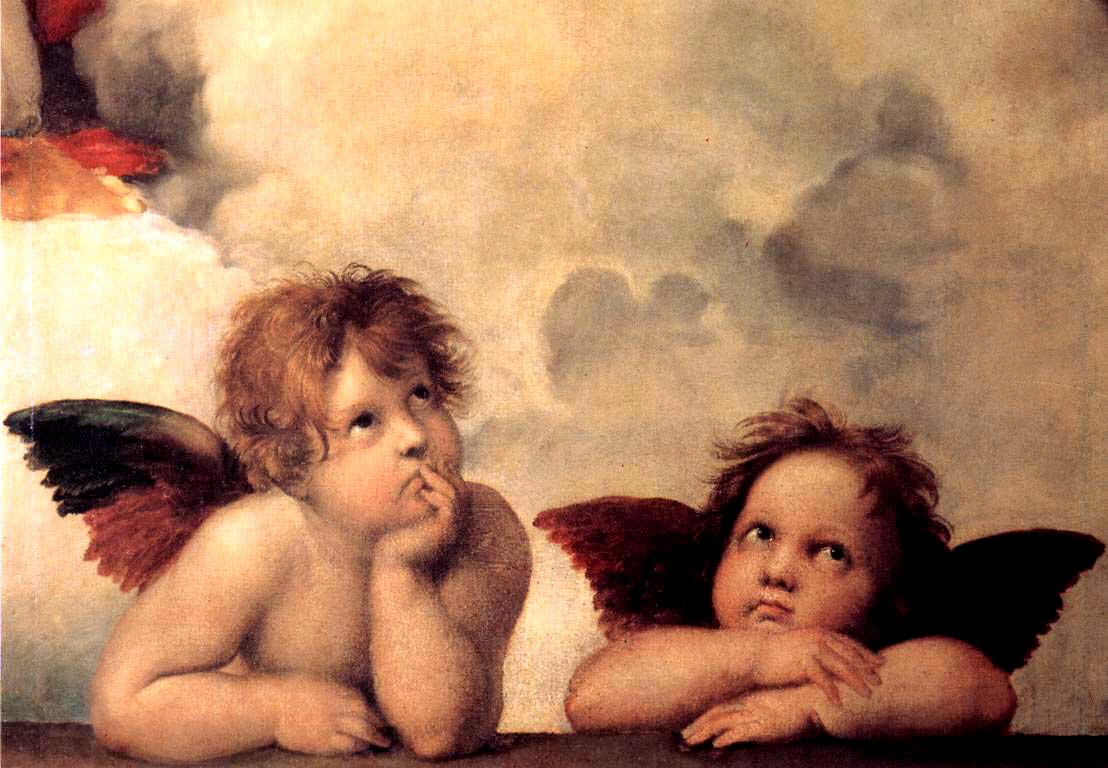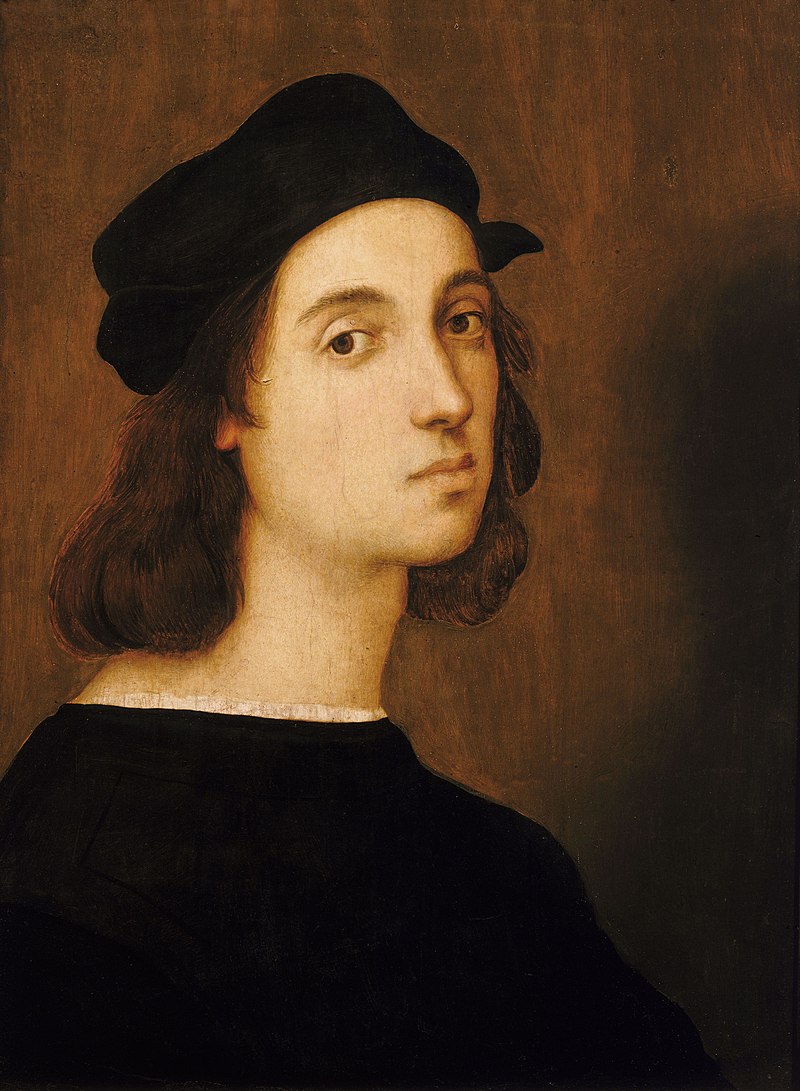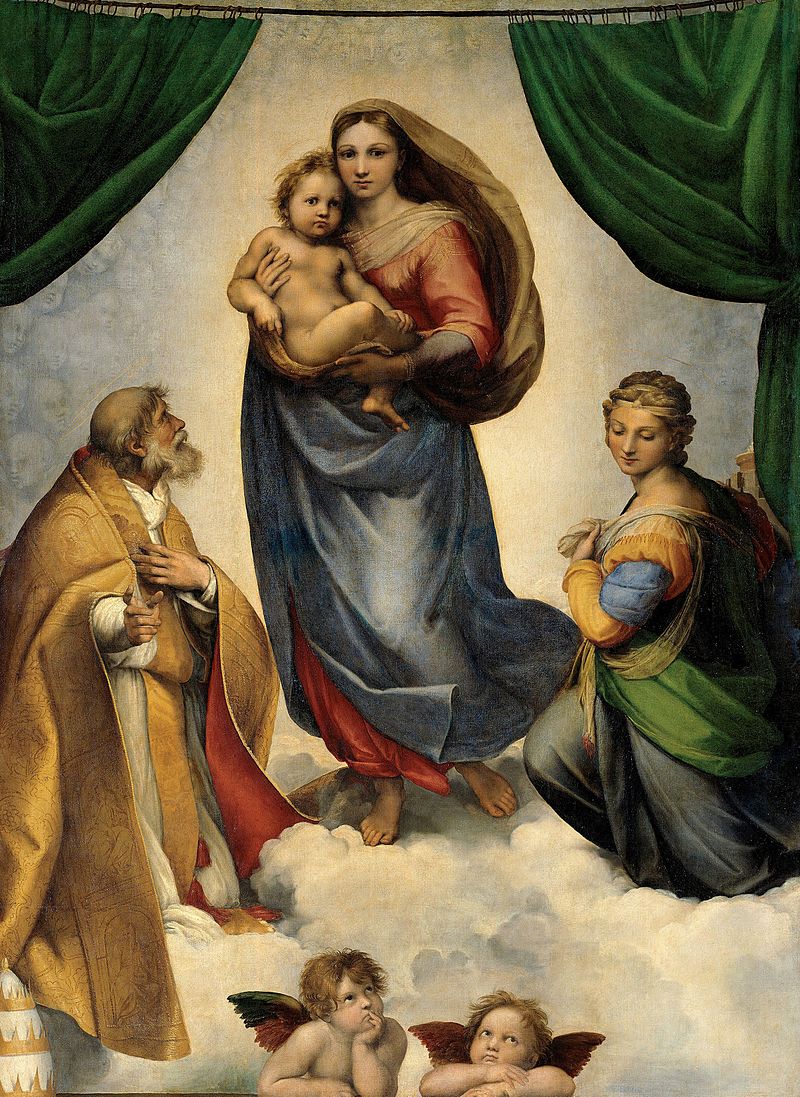Introduction
When discussing prominent Renaissance artists, Raphael is inevitably one of the first names that come to mind. He was a child genius who was brought to Rome by the pope when he was in his mid-20s and given the responsibility of painting some of the most important rooms in the Vatican.
Raphael was an artist who was able to master each medium that was presented to him, including but not limited to oil paintings, frescos, tapestries, and architecture. It should come as no surprise that he, together with Michelangelo and Leonardo da Vinci, is credited as being responsible for shaping this period in the history of art.
Who is Raphael?
Raffaello Sanzio da Urbino was born on April 6, 1483, to Giovanni Santi di Pietro and Magia di Battista di Nicola Ciarla, who were from affluent merchant families from Urbino and Colbordolo in the Marche Region. Raphael’s father worked as a painter for Federigo da Montefeltro, the Duke of Urbino, where he was the leader of a well-known studio during the time that Urbino was a blossoming cultural center. Raphael was named after the Duke of Urbino. Raphael was the only one of the three children to make it through childhood. Raphael was just nine years old when his mother passed away in 1491, and the next year, his father remarried Bernardina, the daughter of a jeweler.
Raphael received much of his early training as a painter from his father. His father also arranged for him to be placed in the studio of Italian Renaissance painter Pietro Perugino when he was eight years old, according to his biographer Giorgio Vasari, who wrote the important book Lives of the Most Excellent Painters, Sculptors, and Architects (1550). Even though it is not certain when his apprenticeship started, it was concluded that he was working as an assistant at Perugino’s studio the year that his father passed away in 1494.
After the passing of Giovanni, Raphael was given the inheritance of his father’s studio, and Giovanni’s brother was given the responsibility of becoming Raphael’s legal guardian. Raphael continued to work in the workshop owned and operated by his father while his uncle took over the studio’s management.
Perugino is generally acknowledged as having been Raphael’s first significant artistic influence. This is even though Raphael went on to get instruction in painting from a court painter named Timoteo Viti in Urbino. Even though he was only 17 years old at the time, due to his extraordinary talent as a painter and the fact that he had completed his apprenticeship, he was immediately recognized as a true master. Because he was so talented at the time, it was impossible to tell whether Perugino or Raphael had been the one to do the work, in terms of either their style or their method.
In the year 1500, Raphael was given his first commission, which was an altarpiece that was intended to be dedicated to Saint Nicholas of Tolentino. The altarpiece was intended for Andrea Baronci’s chapel, which is located in the church of St. Agostino in Città di Castello, which is a town located close to Urbino. Even though it was a collaborative commission with Evangelista da Pian di Meleto, a friend and contemporary of his father, Raphael was recorded as the “Master.” Unfortunately, the altarpiece was destroyed by an earthquake in 1789, and all that is left of it today are shattered pieces that may be found in a variety of collections all over the world.
Important commissions continued to come in after that, one of which was the painting titled “Coronation of the Virgin,” which was completed in 1502 and placed on the altar of the Oddi family chapel in the Church of San Francesco al Prato in Perugia. In 1504, he also made The Marriage of the Virgin, which is considered to be his most important piece. He was inspired to create this work by Perugino’s picture of Christ Delivering the Keys to St. Peter (1482) at this time.
Fra Bartolomeo was the one who convinced Raphael to abandon the delicate and graceful manner of Perugino in favor of a more grandiose style. This conversation took place in Florence. His primary artistic inspiration was Leonardo da Vinci, specifically his composition, his use of gestures to create dialogue, and his pioneering use of chiaroscuro and sfumato methods. Raphael began to create his style using this inspiration, and it rapidly garnered awe and admiration for its simplicity of composition, clarity of form, and visual achievement. These are all remarkable contributions to the Neoplatonic ideals of human grandeur and the Renaissance drives toward presenting beauty. Raphael’s style also quickly garnered awe and veneration for its ease of composition, clarity of form, and aesthetic achievement.
During this time, Raphael produced several Madonnas, which embodied much of Leonardo’s experimenting with realism and composition. Raphael’s Madonnas are some of the most famous paintings in the world. The most well-known instance of this is his artwork titled “La Belle jardinière,” which was completed in 1507. In the latter part of that year, he would publish a work titled “The Entombment,” in which he would make references to Michelangelo’s Battle of Cascina from 1504. It is reported that Michelangelo was enraged by Raphael’s ability to learn from other painters and then develop the knowledge into a signature style of his own. This angered Michelangelo and caused Michelangelo to accuse Raphael of plagiarism.
Raphael was assigned by Pope Leo X to the job of commissioner of antiquities in Rome in 1517. In this role, Raphael was responsible for overseeing the restoration of antiquities. To meet this task, Raphael began sketching up an archaeological map of Rome. His restoration techniques were distinct from those used by prior restorers since he insisted on maintaining the integrity of the items by avoiding the imaginative reconstructions that were popular at the time among other architects. This was done in contrast to the approach taken by other restorers.
During the latter part of his life, Raphael resided in the Palazzo Caprini, a house that had been constructed by Bramante. During this time, he was accorded several honors and accolades, including the illustrious title of Groom of the Chamber, which is a position of prominence inside the Papal Court. In recognition of his many contributions to the illustrious history of the Catholic Church, the Pope bestowed upon him the title of Knight of the Papal Order of the Golden Spur.
In addition to that, he was involved in the construction of various buildings, one of which was the exquisite Palazzo di Jacobo da Brescia, which was built for Pope Leo’s physician. And on the Villa Madama, which was intended to be a rural retreat for Cardinal Giulio de’ Medici, who would later become Pope Clement VII but was never completed due to his untimely death. The Transfiguration (1520), another painting that had been commissioned by Cardinal Giulio de’ Medici, was the artist’s final work. It was supposed to be a massive altarpiece for Narbonne Cathedral in France, and it was the picture that he was working on at the time of his death.
Raphael’s fiancée Maria Bibbiena was expecting the couple to get married, however, the wedding never took place. It was believed that he was mulling over the possibility of becoming a Cardinal, which is a position within the Catholic Church in which marriage is forbidden. It’s also possible that he never genuinely loved her in the first place. He referred to his mistress as “La Fornarina,” although her real name was Margherita Luti. He had a relationship with her. Maria passed away only a couple of months before Raphael himself.
It is reported that by the time Raphael passed away, he had a workshop that contained more than fifty apprentices, making it larger than any other painter’s workshop at the time. Raphael passed away on Good Friday, April 6, 1520, in Rome. He was only 37 years old at the time of his death. He had a brief sickness, but within that time, he was able to get all of his affairs in order and get his final rites before he passed away. Following the traditional practice of the area, his body was shown for public viewing at his residence. This was followed by one of the largest funeral processions of his time, which culminated at the Vatican, where his burial mass was celebrated.
About the Famous Cherubini Painting by Raphael
During his brief life, Raffaello Sanzio da Urbino created a great number of works of art. Even though the artist passed away when they were only 37 years old, they were able to leave us with works of art that are still unparalleled in terms of their inventiveness and talent. The Stanze di Raffaello is a group of chambers that were commissioned by Popes Julius II and Leo X. They are remarkable for the frescoes and delicate paintings that they include. This is his best achievement. They may be found in the Vatican, and their initial purpose was to compete with the splendor of the chambers that belonged to Alexander VI, an earlier Pope who was Alexander VI’s competitor.
The work of Raphael can be broken down into three distinct phases or periods. The first job he ever had was as an apprentice for Perugino, and it was there that he got his start in the industry. The second was spent in Florence, where he learned about and contributed to the development of the cultural tradition. The third was spent in Rome, where he made his most acclaimed artworks and ultimately passed away.
The lower portion of the Sistine Madonna was used to create this stunning picture that was extracted from the original. The renowned master Raffaello was commissioned to make what was later described by Vasari as “a truly rare and extraordinary work.” This was done at the request of Pope Julius II in honor of his uncle Pope Sixtus IV. The Virgin Mary is depicted as the central figure in one of his most recent works of art, which was created to be used as an altarpiece for the basilica church of the Benedictine Monastery of San Sisto. In this particular work, Mary is shown cradling an infant Jesus in her arms. In addition, Saint Barbara and Saint Sixtus can be seen in the background of the painting, floating above the clouds. At the very bottom, we can make out two cherubim with wings, each with an elbow resting on the clouds.
The kid angels have gained fame in and of themselves. Raphael was fascinated by the stance of two youngsters he observed on the street when they were looking longingly at a baker’s shop. He took this as inspiration to paint the Cherubins like how he saw them standing. This section of the Sistine Madonna was reproduced in a significant way across a variety of mediums including t-shirts, music albums, stamps, and many others; as a result, this piece of artwork became one of the most well-known paintings created throughout the Renaissance.
The picture, which is housed in the Gemaldegalerie Alte Meister in Dresden, Germany, and is regarded as one of the greatest paintings to have been produced during the Italian Renaissance, was the final painting to be finished in its whole by Raphael himself. In 1754, the monks at the abbey sold the painting to King Augustus III of Poland, who was residing in Dresden at the time. The price of the sale was twelve thousand zucchini. The abbey currently has a copy on exhibit for visitors to see. The four people that are located in the upper two-thirds of the picture are stunning; nonetheless, the putti have become the most famous parts of the picture. Their likeness has been licensed for use on a wide variety of different commercial products.
About the Sistine Madonna by Raphael
The painting’s correct art-historical title is The Madonna Standing on Clouds with SS. Sixtus and Barbara depict the holy figures in their traditional poses. However, since this is one of those titles that cries out to be shortened, everyone refers to it as the Madonna of the Sistine Chapel. In 1512, Pope Julius II gave Pope Sixtus IV’s nephew, Pope Sixtus IV, the distinction of having the picture created in his honor. The Benedictine Basilica San Sisto in Piacenza, a church with whom the Rovere family had a long-standing relationship, was where it was going to end up when it arrived.
There is a significant amount of background information available regarding the model. It is speculated that she is Margherita Luti, the daughter of Francesco Luti, a baker in ancient Rome. It is generally accepted that Raphael had Margherita as his mistress throughout the final twelve years of his life, beginning at some point in 1508 and continuing until he passed away in 1520. It is important to keep in mind that Raphael and Margherita did not leave behind any paperwork or sign a palimony agreement. However, it appears that their romantic involvement was not a closely guarded secret at all, and there is evidence that the couple was exceedingly at ease with one another.
At least ten paintings were completed with Margherita as the model, six of which were Madonnas. On the other hand, the “mistress” claim is attached to the very final painting, which is titled La Fornarina (1520). In it, she is exposed from the waist up and has a ribbon around her left upper arm that has the name Raphael written on it.
In the year 2000, La Fornarina underwent restoration, and as part of that process, several X-rays were taken to determine what the best course of action would be. These x-rays showed that the original painting of Margherita had her put on a huge ruby ring with a square cut on her left ring finger, and the background featured myrtle and quince branches. These are two points that are highly important to note. Both myrtle and quince were sacred to the Greek goddess Venus; they represented love, sensual desire, fertility, and faithfulness. The ring is unique because it would have likely been the wedding or betrothal ring of a very wealthy man’s bride or bride-to-be.
These particulars were concealed for close to half a millennium, having been hastily painted over just before Raphael passed away. Regardless of whether Margherita was Raphael’s mistress, fiancée, or secret wife, she was unquestionably lovely and inspired sensitive handling of her likeness in every painting for which she posed. Whether she was Raphael’s mistress, fiancée, or secret wife, she was undeniably beautiful.
Since the beginning of the 19th century, the two cherubs that are located at the bottom of the Sistine Madonna have frequently been duplicated alone, without the rest of the painting. They have been printed on an extremely diverse range of items, from stitching samplers to candy tins, umbrellas, and even toilet paper. There are probably hundreds of thousands of individuals who are familiar with them but do not know the name of the larger painting from which they were taken.
Where is the Painting Displayed?
The Sistine Madonna hangs in the Gemaldegalerie Alte Meister of the Staatliche Kunstsammlungen Dresden in Germany. Since 1752 or 1754, the picture has resided in that location, except for the years 1945–1955, when it was in the custody of the Soviet Union. Fortunately for Dresden, the Soviets returned it to Germany in a reasonably timely manner as a gesture of goodwill.
Interesting Facts About Raphael
-
He is Regarded as One of the High Renaissance Masters
During Raphael’s lifetime, his fame was already well-established; yet, it continued to grow after he passed away. His contributions to the evolution of art were immediately recognized, and he is currently acknowledged to be one of the greatest masters of the Italian Renaissance, along with Michelangelo and Leonardo da Vinci.
-
His Father Was a Painter
Raphael was born with a talent for the arts. Raphael’s father, Giovanni Santi, was a painter in the court in the city that Raphael called home. As a result of this, it is quite likely that Raphael spent his formative years interacting with the court. Raphael was just 11 years old when Santi passed away. During his lifetime, Santi painted altarpieces and portraits for the palace of Urbino.
Since his mother passed away when he was only eight years old, this resulted in him being an orphan. Although Raphael was probably too young to have learned much of his artistic practice from his father, he did have significant respect for the arts and humanism at a young age.
-
Raphael’s Rival Was Michelangelo
Michelangelo had already been diligently working for Pope Julius II for three years by the time Raphael arrived in Rome in 1508. Raphael’s arrival in Rome occurred in 1508. Michelangelo, who was eight years older than Raphael and had already established himself in his career, found himself working next door to the young upstart named Raphael. The Pope’s library in the Stanza della Segnatura was the first and greatest commission of Raphael’s career, and he began working on it as soon as he arrived in Rome.
During the same period, Michelangelo was working on the ceiling of the Sistine Chapel, which was located nearby. Michelangelo was disappointed because Raphael’s painting style received a lot of attention and appreciation rather than his own. Because Michelangelo believed that Raphael was imitating his artistic style, this stoked the fires of an intense rivalry between the two painters. Raphael, in turn, painted Michelangelo in the School of Athens as the scowling thinker Heraclitus.
-
He Was Assisted by Many People
Once Raphael had established himself as a master in his own right, he began to build an impressively large studio that included fifty assistants. His assistants were well-trained to take his designs and develop them into finished pieces in his name, which was a normal technique at the time. This was the standard procedure.
-
He Died Early
Raphael had a full and eventful life even though it was cut prematurely. There are certain unanswered questions regarding the circumstances surrounding his passing on his 37th birthday. Pneumonia, lung illness, and fatigue from overwork have all been cited as potential causes of death by historians as probable explanations.
Regardless of the cause of his untimely passing, it was a tragic event. In the two weeks before he passed away, he took care of his business and made arrangements for his burial, specifying that he wanted to be buried in the Pantheon. His wish was realized, and people can visit his tomb even today, even though it was preceded by a lavish burial that was witnessed by vast numbers of people (including the Pope).
Conclusion
Raphael is still revered today even though contemporary art eventually went in a different direction. This is because he brought the art of painting to the highest possible level of technical ability, which succeeding generations would look to as the standard to which they should aspire.



